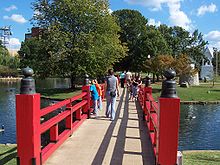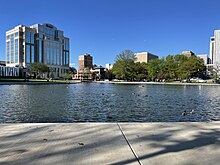United States historic place
| Big Spring | |
| U.S. National Register of Historic Places | |
   | |
| Location | W. Side Sq., Huntsville, Alabama |
|---|---|
| Coordinates | 34°43′47″N 86°35′9″W / 34.72972°N 86.58583°W / 34.72972; -86.58583 |
| Area | 12.5 acres (5.1 ha) (park) |
| MPS | Downtown Huntsville MRA |
| NRHP reference No. | 80000704 |
| Added to NRHP | September 22, 1980 |
Big Spring International Park (also known as Big Spring Park) is a large park located in downtown Huntsville, Alabama. The park was built around its namesake "Big Spring", the original water source that the city of Huntsville was built around. The Huntsville Museum of Art and Von Braun Center are located in the park. The park is also notable as the venue for the Panoply Arts Festival, held the last full weekend in April, Big Spring Jam, an annual music festival held on the fourth weekend in September from 1993 to 2011, and The Battle of the Buffalo, a buffalo wings competition held by the University of Alabama in Huntsville Alpha Tau Omega fraternity to support cancer research.
Big Spring Park is the expected trail head of the future Singing River Trail of North Alabama. A 70-mile bicycling and walking trail, it will connect Huntsville to Madison, Decatur, and Athens with an extended path along the Tennessee River.
The Big Spring
| "Huntsville is situated around the finest spring in the world; the spring forms a semicircle 100 feet wide, and at a trivial expense the stream can be made navigable for batteaux to the Tennessee river; which is only ten miles distant." |
| - future U.S. Senator John Williams Walker, 1815
to his friend and US Secretary of War William H. Crawford |
The Big Spring is a large, underground karst spring. Hearing of the abundant water source and plentiful big game, John Hunt, Huntsville's founder, sought out the spring and settled near it in 1805 on the bluff above, which later became the site of the First National Bank of Huntsville. Isaac and Joseph Criner had previously reached the Big Spring and considered settlement, but due to the presence of bears and mosquitoes left to settle New Market instead. During the 19th century and the first half of the 20th century, the spring was Huntsville's water source, due to its massive flow. The Big Spring is the largest limestone spring in North Alabama, with its usual flow between 7 and 20 million US gallons (76,000 m) per day, depending on the time of the year.
From 1827 to the early 1840s, what would later become the park grounds served as the site of the Fearn Canal, built from 1821 to 1824. The canal was built by the Indian Creek Navigation Company, led by local resident Dr. Thomas Fearn. It linked downtown Huntsville and the spring to the Tennessee River, allowing traders to bypass a costly wagon haul of about 11 miles South to the nearest river port, Ditto's Landing in the town of Whitesburg. The canal eventually became obsolete upon the construction of railroads.
The Big Spring also served as the source of the city's water supply from settlement to the late 1960s when the Tennessee Valley Authority built the water treatment plant on the Tennessee River. The first pumphouse was built in the 1830s. It was enclosed in the 1850s. A water turbine pushed water up the bluffs through cedar pipes to reach the city's residents. Until 1840, the city waterwork's system was privately owned by the family of settler LeRoy Pope. His son sold the land to the city cheaply on the condition his heirs received their water for free and that the space around the Big Spring Basin would be open to the public. The first pumphouse was torn down in 1860 prior to the American Civil War and replaced by the second pumphouse made out of stone. New pumps were put in but little changed during the war. In 1890, the second pumphouse was extended with a new wing and smokestack to meet the new water needs as the city expanded and the new Monte Sano Hotel opened. This pumphouse was torn down by Col. Hiram M. Chittenden of the U.S. Army Corps of Engineers in 1899, and the waterworks system was moved further into the city. The third pumphouse would stand near California Street until the 1960s, when the water treatment plant would be built on the Tennessee River.
The Park

Big Spring Park is named for a spring named "the big spring" by the indigenous Cherokee and Chickasaw. The original park site is situated in downtown Huntsville, starting from the west side of the courthouse square, and extending about two blocks southwest. This part of the park includes the spring itself and a canal extending to the rest of the park. The park's construction began September 21, 1898, under the direction of Chittenden of the U.S. Army Corps of Engineers, stationed at the park during the Spanish–American War. Col. Chittenden became interested in the park and the source of the Big Spring. While exploring the source of the Big Spring, he discovered that horse waste from the courthouse square above was seeping into the city's water supply that the Big Spring produced. Col. Chittenden and his men tore down the pumphouse located at the basin of the Big Spring, put in a fountain, and lined the canal from 1898 to 1901. The park expanded across Church Street to the space which now has the park's lagoon in 1968. In 2005, the park underwent additional expansion across Monroe Street to include a $284,000 fountain and a canal alongside the Von Braun Center.
Today the park prominently features gifts given by other countries and foreign nationals to the city of Huntsville, including a 1903 light beacon (often referred to as "the lighthouse") and a 1929 fog bell given by Norway in 1973. Other smaller gifts include a bench from the United Kingdom and a sundial from Germany.

The most recognizable gifts, however, are the iconic red Japanese bridge and cherry trees, given by Japanese Major General Mikio Kimata. From 1964 to 1966, Kimata, then a Lieutenant Colonel, attended Redstone Arsenal's Ordnance Guided Missile School program. As thanks to the city for its hospitality when hosting him, Kimata donated the original 60 Yoshino Cherry trees. He followed up on this gift with the donation of a "friendship bridge" to celebrate the United States Bicentennial. The bridge was formally dedicated on May 3, 1977. In 1998, Kimata and the Japanese Society of Alabama partially financed a major $36,000 renovation of the bridge. The bridge was restyled, expanded, and given a gentler slope.

A final gift, restored to its proper place in 1995, was the marble lion that sits near the Big Spring Fountain. The city was given the marble lion to commemorate the opening of the park. In the late 1960s, it had been pushed into the canal by vandals. It was salvaged and restored in 1995.
The park served as a major filming location in Constellation, a 2005 feature film.
Big Spring Park was one of the locations of a George Floyd protest that occurred on June 3, 2020, which was ended by Huntsville Police along with SWAT and Incident Response Team using tear gas, pepper spray, and rubber bullets.
See also
Notes
- "National Register Information System". National Register of Historic Places. National Park Service. July 9, 2010.
- Sallee, pp. 22.
- Cure
- "Singing River Trail Master Plan" (PDF). July 1, 2019. p. 29. Archived (PDF) from the original on July 23, 2020. Retrieved July 22, 2020.
- Singleterry, Sarah (February 5, 2019). "Singing River Trail gets positive community feedback". WAAY 31. Retrieved July 22, 2020.
- Ballard, Kimberly (December 31, 2019). "Singing River Trail a Merger of Native American History and Smart Technology". Huntsville Business Journal. Retrieved July 22, 2020.
- Betts, pp. 28.
- ^ Betts, p. 7.
- ^ Doyle, 2008.
- ^ LaMoreaux, p. 368.
- Richardson
- Betts, pp. 66-70.
- Peck
- ^ Sallee, pp. 21.
- ^ Bonvillian
- Doyle, 2010.
- Lightfoot, Franklin & White, LLC (April 22, 2021). "Report by Independent Counsel to The Huntsville Police Citizens Advisory Council" (PDF): 50 of 248. Retrieved August 29, 2021.
{{cite journal}}: Cite journal requires|journal=(help)CS1 maint: multiple names: authors list (link) - Klapp, Caroline (April 23, 2021). "Breakdown of 248 page report on Huntsville Police response to June 2020 protests". WAFF 48 News. Gray Media Group, Inc. Station. NBC. Retrieved August 30, 2021.
- Remkus, Ashley (April 23, 2021). "Protest review finds 'unprofessional' behavior, policy violations by Huntsville police". The Huntsville Times. Retrieved August 29, 2021.
- "UPDATED: Downtown Huntsville protest ends with riot gas, arrests". WAFF 48 News. Gray Media Group, Inc. NBC. June 4, 2020. Retrieved August 30, 2021.
References
- Betts, Edward Chambers (1916). Early History of Huntsville, Alabama: 1804 to 1870. Brown Printing Company.
- Bonvillian, Crystal (October 17, 2010). "Bridge fans give park landmark fresh look". The Huntsville Times.
- Cure, Sarah (November 3, 2011). "Big Spring Jam officials evaluating new ideas after disappointing turnout in 2011". The Huntsville Times. Retrieved December 5, 2011.
- Doyle, Steve (December 7, 2008). "City father Hunt no mere pioneer". The Huntsville Times. Archived from the original on November 14, 2012. Retrieved October 16, 2019.
- Doyle, Steve (October 10, 2010). "Volunteers will repaint Huntsville's iconic Japanese bridge next weekend". The Huntsville Times.
- LaMoreaux, P.E.; Powell, W.J. (1963). Stratigraphic and Structural Guides to the Development of Water Wells and Well Fields in a Limestone Terrain (PDF). Archived from the original (PDF) on July 19, 2011. Retrieved October 26, 2010.
- Peck, John (October 13, 2005). "Fountain centerpiece to honor civic leader". The Huntsville Times. Archived from the original on July 7, 2011. Retrieved October 26, 2010.
- Richardson, L.W. (March 20, 1976), "Fearn Canal (Indian Creek Nav. Co.)", American Canal Society Canal Index (PDF), archived from the original (PDF) on August 20, 2008
- Sallee, Rebecca (April 2005). "Beautiful Reminders of Friendship: International Exchange is Huntsville's Heritage" (PDF). Initiatives. Huntsville/Madison County Chamber of Commerce. Archived from the original (PDF) on November 24, 2010. Retrieved October 26, 2010.
External links
- Panoply Arts Festival official website Archived 2010-09-03 at the Wayback Machine
| U.S. National Register of Historic Places | |
|---|---|
| Topics | |
| Lists by state |
|
| Lists by insular areas | |
| Lists by associated state | |
| Other areas | |
| Related | |
- Huntsville-Decatur, AL Combined Statistical Area
- Parks in Alabama
- Springs of Alabama
- Geography of Huntsville, Alabama
- Culture of Huntsville, Alabama
- Protected areas of Madison County, Alabama
- Tourist attractions in Huntsville, Alabama
- Parks in Huntsville, Alabama
- National Register of Historic Places in Huntsville, Alabama
- Bodies of water of Madison County, Alabama
- Parks on the National Register of Historic Places in Alabama